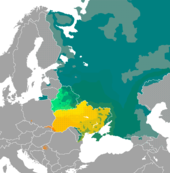Slavs are a European ethno-linguistic group of people who speak the various Slavic languages of the larger Balto-Slavic linguistic group of the Indo-European languages. They are native to Eurasia, stretching from Central, Eastern and Southeastern Europe all the way north and eastwards to Northeast Europe, Northern Asia(Siberia) and Central Asia (especially Kazakhstan and Turkmenistan), as well as historically in Western Europe(particularly in Eastern Germany) and Western Asia (including Anatolia). From the early 6th century they spread to inhabit most of Central, Eastern and Southeastern Europe. Today, there is a large Slavic diaspora throughout the Americas, particularly in the United States, Canada and Brazil as a result of immigration.
Slavs are the largest ethno-linguistic group in Europe. Present-day Slavic people are classified into East Slavs (chiefly Belarusians, Russians, Rusyns, and Ukrainians), West Slavs (chiefly Czechs, Kashubs, Poles, Slovaks, and Sorbs) and South Slavs (chiefly Bosniaks, Bulgarians, Croats, Macedonians, Montenegrins, Serbsand Slovenes).
Most Slavs are traditionally Christians. Eastern Orthodox Christianity, first introduced by missionaries from the Byzantine empire, is practiced by the majority of Slavs. The Orthodox Slavs include the Belarusians, Bulgarians, Macedonians, Montenegrins, Russians, Serbs, and Ukrainians and are defined by Orthodox customs and Cyrillic script (Montenegrins and Serbians also use Latin script on equal terms).
The second most common type of Christianity among the Slavs is Catholicism, introduced by Latin-speaking missionaries from Western Europe. The Catholic Slavs include Croats, Czechs, Kashubs, Poles, Silesians, Slovaks, Slovenes and Sorbs and are defined by their Latinate influence and heritage and connection to Western Europe. Millions of Slavs also belong to Greek Catholic churches—that is, historically Orthodox communities that are now in visible unity with Rome and the Catholic Church, but which retain Byzantine practices, such as the Rusyns. There are also substantial Protestant, in particular Lutheran, minorities, especially among the West Slavs, such as the historical Bohemian (Czech) Hussites.
A small number of Slavic ethnic groups traditionally adhere to Islam. Muslim Slavs include the Bosniaks, Pomaks (Bulgarian Muslims), Gorani, Torbeši (Macedonian Muslims) and other Muslims of the former Yugoslavia.
Modern Slavic nations and ethnic groups are considerably diverse both genetically and culturally, and relations between them – even within the individual groups – range from “ethnic solidarity to mutual feelings of hostility”.
Ethnonym
The oldest mention of the Slavic ethnonym is the 6th century AD Procopius, writing in Byzantine Greek, using various forms such as Sklaboi (Σκλάβοι), Sklabēnoi (Σκλαβηνοί), Sklauenoi (Σκλαυηνοί), Sthlabenoi (Σθλαβηνοί), or Sklabinoi (Σκλαβῖνοι), while his contemporary Jordanes refers to the Sclaveni in Latin. The oldest documents written in Old Church Slavonic, dating from the 9th century, attest the autonym as Slověne (Словѣне). These forms point back to a Slavic autonym which can be reconstructed in Proto-Slavic as *Slověninъ, plural Slověne.
The reconstructed autonym *Slověninъ is usually considered a derivation from slovo (“word”), originally denoting “people who speak (the same language)”, i. e. people who understand each other, in contrast to the Slavic word denoting German people, namely *němьcь, meaning “silent, mute people” (from Slavic *němъ “mute, mumbling”). The word slovo (“word”) and the related slava (“glory, fame”) and slukh (“hearing”) originate from the Proto-Indo-European root *ḱlew- (“be spoken of, glory”), cognate with Ancient Greek κλέος(kléos “fame”), as in the name Pericles, Latin clueo (“be called”), and English loud.
In Medieval and Early Modern sources written in Latin, Slavs are most commonly referred to as Sclaveni, or in shortened version Sclavi.
History
Origins
First mentions
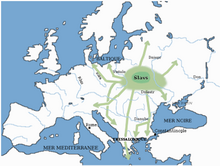
The origin and migration of Slavs in Europe between the 5th and 10th centuries AD
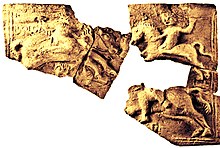
Terracotta tile from the 6th–7th century AD found in Vinica, North Macedonia depicts a battle scene between the Bulgars and Slavs with the Latin inscription BOLGAR and SCLAVIGI
Ancient Roman sources refer to the Early Slavic peoples as Veneti, who dwelt in a region of central Europe east of the Germanic tribe of Suebi, and west of the Iranian Sarmatians in the 1st and 2nd centuries AD. The Slavs under name of the Antes and the Sclaveni first appear in Byzantine records in the early 6th century. Byzantine historiographers under emperor Justinian I (527–565), such as Procopius of Caesarea, Jordanes and Theophylact Simocatta describe tribes of these names emerging from the area of the Carpathian Mountains, the lower Danube and the Black Sea, invading the Danubian provinces of the Eastern Empire.
Jordanes, in his work Getica (written in 551 AD), describes the Veneti as a “populous nation” whose dwellings begin at the sources of the Vistula and occupy “a great expanse of land”. He also describes the Veneti as the ancestors of Antes and Slaveni, two early Slavic tribes, who appeared on the Byzantine frontier in the early 6th century. Procopius wrote in 545 that “the Sclaveni and the Antae actually had a single name in the remote past; for they were both called Sporoi in olden times”. The name Sporoi derives from Greek σπείρω (“I scatter grain”). He described them as barbarians, who lived under democracy, believed in one god, “the maker of lightning” (Perun), to whom they made a sacrifice. They lived in scattered housing and constantly changed settlement. In war, they were mainly foot soldiers with small shields and spears, lightly clothed, some entering battle naked with only genitals covered. Their language is “barbarous” (that is, not Greek), and the two tribes are alike in appearance, being tall and robust, “while their bodies and hair are neither very fair or blond, nor indeed do they incline entirely to the dark type, but they are all slightly ruddy in color. And they live a hard life, giving no heed to bodily comforts…” Jordanes described the Sclaveni having swamps and forests for their cities. Another 6th-century source refers to them living among nearly impenetrable forests, rivers, lakes, and marshes.
Menander Protector mentions a Daurentius (circa 577–579) who slew an Avar envoy of Khagan Bayan I for asking the Slavs to accept the suzerainty of the Avars; Daurentius declined and is reported as saying: “Others do not conquer our land, we conquer theirs – so it shall always be for us”.
Migrations
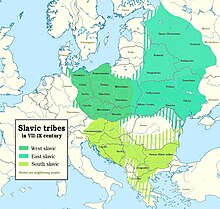
Slavic tribes from the 7th to 9th centuries AD in Europe
According to eastern homeland theory, prior to becoming known to the Roman world, Slavic-speaking tribes were part of the many multi-ethnic confederacies of Eurasia – such as the Sarmatian, Hun and Gothic empires. The Slavs emerged from obscurity when the westward movement of Germanic tribes in the 5th and 6th centuries CE (thought to be in conjunction with the movement of peoples from Siberia and Eastern Europe: Huns, and later Avars and Bulgars) started the great migration of the Slavs, who settled the lands abandoned by Germanic tribes fleeing the Huns and their allies: westward into the country between the Oder and the Elbe-Saale line; southward into Bohemia, Moravia, much of present-day Austria, the Pannonian plain and the Balkans; and northward along the upper Dnieper river. It has also been suggested that some Slavs migrated with the Vandals to the Iberian Peninsula and even North Africa.
Around the 6th century, Slavs appeared on Byzantine borders in great numbers. Byzantine records note that Slav numbers were so great, that grass would not regrow where the Slavs had marched through. After a military movement even the Peloponnese and Asia Minor were reported to have Slavic settlements. This southern movement has traditionally been seen as an invasive expansion. By the end of the 6th century, Slavs had settled the Eastern Alps regions.
Pope Gregory I in 600 CE wrote to Maximus, the bishop of Salona (in Dalmatia), in which he expresses concern about the arrival of the Slavs: “Et quidem de Sclavorum gente, quae vobis valde imminet, et affligor vehementer et conturbor. Affligor in his quae jam in vobis patior; conturbor, quia per Istriae aditum jam ad Italiam intrare coeperunt.” (And as for the people of the Slavs who are really approaching you, I am very depressed and confused. I am depressed because I sympathize with you, confused because they over the Istria began to enter Italy.)
Middle Ages

Great Moravia was one of the first major Slavic states, 833–907 AD
When Slav migrations ended, their first state organizations appeared, each headed by a prince with a treasury and a defense force. In the 7th century, the Frankish merchant Samo supported the Slavs against their Avar rulers and became the ruler of the first known Slav state in Central Europe, Samo’s Empire. This early Slavic polity probably did not outlive its founder and ruler, but it was the foundation for later West Slavic states on its territory. The oldest of them was Carantania; others are the Principality of Nitra, the Moravian principality (see under Great Moravia) and the Balaton Principality. The First Bulgarian Empire was founded in 681 as an alliance between the ruling Bulgars and the numerous slavs in the area, and their South Slavic language, the Old Church Slavonic, became the main and official language of the empire in 864. Bulgaria was instrumental in the spread of Slavic literacy and Christianity to the rest of the Slavic world. The expansion of the Magyars into the Carpathian Basin and the Germanization of Austria gradually separated the South Slavs from the West and East Slavs. Later Slavic states, which formed in the following centuries, included the Kievan Rus’, the Second Bulgarian Empire, the Kingdom of Poland, Duchy of Bohemia, the Kingdom of Croatia, Banate of Bosnia and the Serbian Empire.
Modern era

Seal from the pan-Slavic Congress held in Prague, 1848
In the late 19th century, there were only four Slavic states in the world: the Russian Empire, the Principality of Serbia, the Principality of Montenegroand the Principality of Bulgaria. In the Austro-Hungarian Empire, out of approximately 50 million people, about 23 million were Slavs. The Slavic peoples who were, for the most part, denied a voice in the affairs of Austria-Hungary, called for national self-determination. Because of the vastness and diversity of the territory occupied by Slavic people, there were several centers of Slavic consolidation. At the beginning of the 20th century, following the end of World War I and the collapse of the Central Powers, several Slavic nations re-emerged and became independent, such as the Second Polish Republic, First Czechoslovak Republic, and the Kingdom of Yugoslavia (officially named Kingdom of Serbs, Croats and Slovenes until 1929). After the end of the Cold War and subsequent collapse of the Soviet Union, Czechoslovakia, and Yugoslavia, additional new Slavic states emerged, such as the Czech Republic, Slovakia, Slovenia, Croatia, Bosnia and Herzegovina, Serbia, Montenegro, North Macedonia, Belarus, Russiaand Ukraine.
Pan-Slavism
Pan-Slavism, a movement which came into prominence in the mid-19th century, emphasized the common heritage and unity of all the Slavic peoples. The main focus was in the Balkans where the South Slavs had been ruled for centuries by other empires: the Byzantine Empire, Austria-Hungary, the Ottoman Empire, and Venice.
Languages
East Slavic languages.
South Slavic languages.
Slovene
Croatian
Bosnian
Serbian
Montenegrin
Torlakian (transitional dialect)
Macedonian
Bulgarian
West Slavic languages.
Proto-Slavic, the supposed ancestor language of all Slavic languages, is a descendant of common Proto-Indo-European, via a Balto-Slavic stage in which it developed numerous lexical and morphophonological isoglosses with the Baltic languages. In the framework of the Kurgan hypothesis, “the Indo-Europeans who remained after the migrations became speakers of Balto-Slavic”. Proto-Slavic is defined as the last stage of the language preceding the geographical split of the historical Slavic languages. That language was uniform, and on the basis of borrowings from foreign languages and Slavic borrowings into other languages, cannot be said to have any recognizable dialects – this suggests that there was, at one time, a relatively small Proto-Slavic homeland.
Slavic linguistic unity was to some extent visible as late as Old Church Slavonic (or Old Bulgarian) manuscripts which, though based on local Slavic speech of Thessaloniki, could still serve the purpose of the first common Slavic literary language. Slavic studies began as an almost exclusively linguistic and philological enterprise. As early as 1833, Slavic languages were recognized as Indo-European.
Standardised Slavic languages that have official status in at least one country are: Belarusian, Bosnian, Bulgarian, Croatian, Czech, Macedonian, Montenegrin, Polish, Russian, Serbian, Slovak, Slovene, and Ukrainian. Russian is the most spoken among Slavic languages, and it is also the most spoken native language in Europe.
The alphabets used for Slavic languages are frequently connected to the dominant religion among the respective ethnic groups. Orthodox Christians use the Cyrillic alphabet while Catholics use the Latin alphabet; the Bosniaks, who are Muslim, also use the Latin alphabet. Additionally, some Eastern Catholics and Western Catholics use the Cyrillic alphabet. Serbian and Montenegrin use both the Cyrillic and Latin alphabets. There is also a Latin script to write in Belarusian, called Łacinka.
Ethno-cultural subdivisions
Slavs are customarily divided along geographical lines into three major subgroups: West Slavs, East Slavs, and South Slavs, each with a different and a diverse background based on the unique history, religion and culture of particular Slavic groups within them. Apart from prehistorical archaeological cultures, the subgroups have had notable cultural contact with non-Slavic Bronze- and Iron Age civilisations. Modern Slavic nations and ethnic groups are considerably diverse both genetically and culturally, and relations between them – even within the individual ethnic groups themselves – are varied, ranging from a sense of connection to mutual feelings of hostility.
West Slavs originate from early Slavic tribes which settled in Central Europe after the East Germanic tribes had left this area during the migration period. They are noted as having mixed with Germanics, Hungarians, Celts(particularly the Boii), Old Prussians, and the Pannonian Avars. The West Slavs came under the influence of the Western Roman Empire (Latin) and of the Catholic Church.
East Slavs have origins in early Slavic tribes who mixed and contacted with Finno-Ugric peoples and Balts. Their early Slavic component, Antes, mixed or absorbed Iranians, and later received influence from the Khazars and Vikings. The East Slavs trace their national origins to the tribal unions of Kievan Rus’ and Rus’ Khaganate, beginning in the 10th century. They came particularly under the influence of the Byzantine Empire and of the Eastern Orthodox Church.
South Slavs from most of the region have origins in early Slavic tribes who mixed with the local Proto-Balkanic tribes (Illyrian, Dacian, Thracian, Paeonian, Hellenic tribes), and Celtic tribes (particularly the Scordisci), as well as with Romans (and the Romanized remnants of the former groups), and also with remnants of temporarily settled invading East Germanic, Asiatic or Caucasian tribes such as Gepids, Huns, Avars, Goths and Bulgars. The original inhabitants of present-day Slovenia and continental Croatia have origins in early Slavic tribes who mixed with Romans and romanized Celtic and Illyrian people as well as with Avars and Germanic peoples (Lombards and East Goths). The South Slavs (except the Slovenes and Croats) came under the cultural sphere of the Eastern Roman Empire (Byzantine Empire), of the Ottoman Empire and of the Eastern Orthodox Church and Islam, while the Slovenes and the Croats were influenced by the Western Roman Empire (Latin) and thus by the Catholic Church in a similar fashion to that of the West Slavs.
Religion

The “Zbruch Idol” preserved at KrakowArchaeological Museum
The pagan Slavic populations were Christianized between the 7th and 12th centuries. Orthodox Christianity is predominant among East and South Slavs, while Catholicism is predominant among West Slavs and some western South Slavs. The religious borders are largely comparable to the East–West Schism which began in the 11th century. Islam first arrived in the 7th century during the early Muslim conquests, and was gradually adopted by a number of Slavic ethnic groups through the centuries in the Balkans.
Among Slavic populations who profess a religion, the majority of contemporary Christian Slavs are Orthodox, followed by Catholic, while a small minority are Protestant. The majority of Muslim Slavs follow the Hanafi school of the Sunni branch of Islam. Religious delineations by nationality can be very sharp; usually in the Slavic ethnic groups, the vast majority of religious people share the same religion. In the Czech Republic 75% had no stated religion according to the 2011 census.
Mainly Eastern Orthodoxy:
|
Mainly Catholicism:
|
Mainly Islam:
|
Relations with non-Slavic people

First Bulgarian Empire, the Bulgars were a Turkic semi-nomadic warrior tribe that became Slavicized in the 7th century AD
Throughout their history, Slavs came into contact with non-Slavic groups. In the postulated homeland region (present-day Ukraine), they had contacts with the Iranian Sarmatians and the Germanic Goths. After their subsequent spread, the Slavs began assimilating non-Slavic peoples. For example, in the Balkans, there were Paleo-Balkan peoples, such as Romanized and Hellenized (Jireček Line) Illyrians, Thracians and Dacians, as well as Greeks and Celtic Scordisci and Serdi. Because Slavs were so numerous, most indigenous populations of the Balkans were Slavicized. Thracians and Illyrians mixed as ethnic groups in this period. A notable exception is Greece, where Slavs were Hellenized because Greeks were more numerous, especially with more Greeks returning to Greece in the 9th century and the influence of the church and administration, however, Slavicized regions within Macedonia, Thrace and Moesia Inferior also had a larger portion of locals compared to migrating Slavs. Other notable exceptions are the territory of present-day Romania and Hungary, where Slavs settled en route to present-day Greece, North Macedonia, Bulgaria and East Thrace but assimilated, and the modern Albanian nation which claims descent from Illyrians and other Balkan tribes.
Ruling status of Bulgars and their control of land cast the nominal legacy of the Bulgarian country and people onto future generations, but Bulgars were gradually also Slavicized into the present-day South Slavic ethnic group known as Bulgarians. The Romance speakers within the fortified Dalmatian cities retained their culture and language for a long time. Dalmatian Romance was spoken until the high Middle Ages, but, they too were eventually assimilated into the body of Slavs.
In the Western Balkans, South Slavs and Germanic Gepids intermarried with invaders, eventually producing a Slavicized population. In Central Europe, the West Slavs intermixed with Germanic, Hungarian, and Celtic peoples, while in Eastern Europe the East Slavs had encountered Finnic and Scandinavian peoples. Scandinavians (Varangians) and Finnic peoples were involved in the early formation of the Rus’ state but were completely Slavicized after a century. Some Finno-Ugric tribes in the north were also absorbed into the expanding Rus population. In the 11th and 12th centuries, constant incursions by nomadic Turkic tribes, such as the Kipchak and the Pecheneg, caused a massive migration of East Slavic populations to the safer, heavily forested regions of the north. In the Middle Ages, groups of Saxon ore miners settled in medieval Bosnia, Serbia and Bulgaria, where they were Slavicized.
Saqaliba refers to the Slavic mercenaries and slaves in the medieval Arab world in North Africa, Sicily and Al-Andalus. Saqaliba served as caliph’s guards. In the 12th century, Slavic piracy in the Baltics increased. The Wendish Crusade was started against the Polabian Slavs in 1147, as a part of the Northern Crusades. The pagan chief of the Slavic Obodrite tribes, Niklot, began his open resistance when Lothar III, Holy Roman Emperor, invaded Slavic lands. In August 1160 Niklot was killed, and German colonization (Ostsiedlung) of the Elbe-Oder region began. In Hanoverian Wendland, Mecklenburg-Vorpommern and Lusatia, invaders started germanization. Early forms of germanization were described by German monks: Helmold in the manuscript Chronicon Slavorum and Adam of Bremen in Gesta Hammaburgensis ecclesiae pontificum. The Polabian languagesurvived until the beginning of the 19th century in what is now the German state of Lower Saxony. In Eastern Germany, around 20% of Germans have historic Slavic paternal ancestry, as revealed in Y-DNA testing. Similarly, in Germany, around 20% of the foreign surnames are of Slavic origin.
Cossacks, although Slavic-speaking and practicing Orthodox Christianity, came from a mix of ethnic backgrounds, including Tatars and other Turks. Initially, the Cossacks were a mini-subethnos, but now they are less than 5%, and most of them live in the east of Ukraine. Many early members of the Terek Cossacks were Ossetians. The Gorals of southern Poland and northern Slovakia are partially descended from Romance-speaking Vlachs, who migrated into the region from the 14th to 17th centuries and were absorbed into the local population. The population of Moravian Wallachia also descended from the Vlachs. Conversely, some Slavs were assimilated into other populations. Although the majority continued towards Southeast Europe, attracted by the riches of the area that became the state of Bulgaria, a few remained in the Carpathian Basin in Central Europe and were assimilated into the Magyar people. Numerous river and other place names in Romania have Slavic origin.
Population
There are an estimated ca. 350 million Slavs worldwide.

Population of Slavs in the Slavic countries
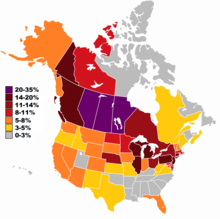
Slavs in the US and Canada by area:
| Ethnicity | Nation-state | Approximate numbers | |
|---|---|---|---|
| Russians | 129,000,000 — 134,000,000 | ||
| Poles | 60,000,000 | ||
| Ukrainians | 37,000,000 — 40,000,000 | ||
| Serbians | 10,000,000 | ||
| Czechs | 9,500,000 — 14,000,000 | ||
| Belarusians | 9,500,000 — 10,000,000 | ||
| Bulgarians (incl. Banat Bulgarians andPomaks) |
8,000,000 — 10,000,000 | ||
| Croats | 6,000,000 — 9,000,000 | ||
| Slovaks | 5,500,000 — 7,000,000 | ||
| Bosniaks (before Bosnian Muslims) |
2,200,000 – 3,000,000 | ||
| Slovenes | 2,000,000 — 2,500,000 | ||
| Macedonians (incl. Torbeši) |
1,800,000 — 2,400,000 | ||
| Silesians | 173,000 — 860,000 | ||
| Moravians | 630,000 — 700,000 | ||
| Yugoslavs | and other countries ex-Yugoslavia |
380,000 — 415,000 | |
| Rusyns (incl. Lemkos) |
350,000 — 1,600,000 | ||
| Slavs in Greece | 350,000 — 600,000 | ||
| Czechoslovaks | 335,000 — 350,000 | ||
| Montenegrins | 330,000 — 460,000 | ||
| Kashubians | 233,000 — 570,000 | ||
| * Slavs (American or Canadian Slavs) |
— | 140,000 — 200,000 | |
| Slavic Muslims | 100,000 — 140,000 | ||
| Sorbs | 65,000 — 150,000 | ||
| Gorani | 35,000 — 60,000 | ||
| Bunjevci (incl. Šokci) |
c. 20,000 | ||

